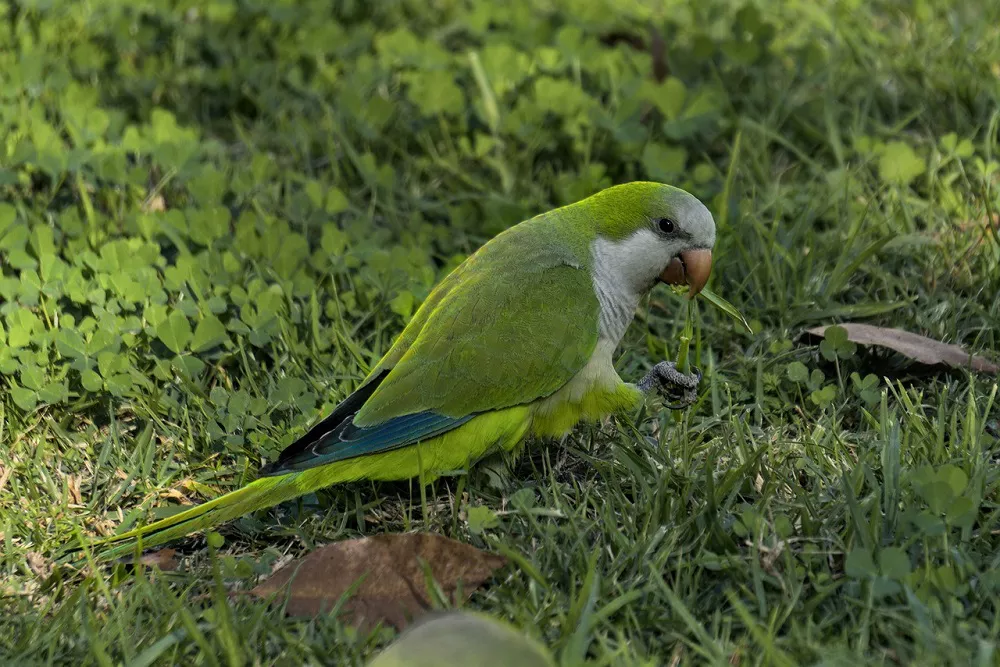Quaker parrots, also known as monk parakeets, are a popular bird species among avian enthusiasts. These birds have a distinct personality and are known for their playful and social nature. However, before considering bringing one of these feathered friends home, it is essential to understand what they look like so that you can provide them with the best care possible.
In this article, we will explore the physical characteristics of Quaker parrots in detail.
Physical Description
Quaker parrots have a stocky build with a rounded head and a short tail. They usually grow to be around 12 inches long, including their tail. Their wingspan ranges from 18 to 20 inches, making them a medium-sized bird.
Feathers
Quaker parrots have a predominantly green plumage, with shades ranging from bright lime to deeper olive green. The feathers on their head and neck may be slightly darker than those on their body. They have blue flight feathers on their wings, which are visible when they are in flight or if they stretch their wings out.
One unique feature of Quaker parrots is the greyish-blue feathers on their forehead and cheeks. These feathers form a distinctive pattern that resembles a mask, which is why they are sometimes referred to as “monk” parrots.
Beak
The beak of a Quaker parrot is short and stout, with a sharp tip. It is usually light grey or beige in color, and it is perfect for cracking open seeds and nuts, which are a staple in their diet.
Eyes
Quaker parrots have large, dark eyes that give them a curious and intelligent expression. These birds are known for their high intelligence levels and ability to mimic human speech and sounds.
Legs and Feet
The legs and feet of a Quaker parrot are short and strong. They have two toes pointing forward and two backward, which allows them to grip branches and perches easily. Their feet are grey and have sharp claws, which they use for climbing and grasping objects.
Sexual Dimorphism
Unlike other bird species, it is challenging to determine the sex of Quaker parrots based on their physical appearance alone. Both males and females usually have the same coloring and body shape. However, some breeders claim that males may have a slightly larger head than females, but this is not a reliable way to sex a Quaker parrot. The only sure way to determine the sex of a Quaker parrot is through DNA testing or surgical sexing.
Personality and Behavior
Quaker parrots are known for their playful and social nature. They love to interact with their owners and thrive on attention. These birds enjoy playing with toys and exploring their environment. They are also excellent at mimicking sounds and words, making them a popular pet among those who enjoy teaching their pets new tricks.
Quaker parrots are flock animals, so they crave the company of other birds or humans. They can become quite vocal if they feel lonely or neglected. Therefore, if you plan to adopt a Quaker parrot, make sure that you can provide plenty of social interaction and mental stimulation.
Caring for a Quaker Parrot
If you plan to adopt a Quaker parrot, it is essential to provide them with proper care to ensure their health and happiness. Here are some tips for caring for your feathered friend:
-
Diet
A balanced diet is crucial for the health of your Quaker parrot. Make sure to provide them with a variety of foods, including high-quality pellets, fresh fruits and vegetables, and occasional treats like nuts and seeds. Avoid feeding them foods that are high in fat, sugar, or salt, as these can lead to obesity and other health problems.
-
Environment
Quaker parrots require a spacious cage with plenty of room to move around. Make sure that the cage is placed in a draft-free area away from direct sunlight, air conditioning vents, or other sources of extreme temperature changes. Provide your bird with toys, perches, and other items that stimulate their curiosity and mental activity.
-
Grooming
Regular grooming is essential for Quaker parrots to maintain their health and appearance. Trim their wings and nails regularly to prevent injury or accidents. Also, provide them with fresh water for bathing to keep their feathers clean and healthy.
-
Health Checks
Regular health checks are crucial for detecting any potential health issues early on. Take your Quaker parrot to an avian veterinarian at least once a year for a check-up and make sure to keep up with any recommended vaccinations or parasite control measures.
Conclusion
In conclusion, Quaker parrots are beautiful birds with distinct physical characteristics that set them apart from other bird species. They have a playful and social personality and require proper care to ensure their health and happiness.
Related topics:


 Facebook
Facebook  Instagram
Instagram  Youtube
Youtube 